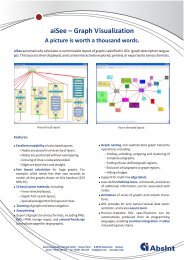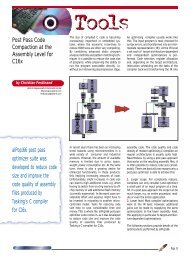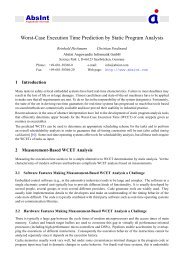5 Graph Description Language (GDL) - Absint
5 Graph Description Language (GDL) - Absint
5 Graph Description Language (GDL) - Absint
Create successful ePaper yourself
Turn your PDF publications into a flip-book with our unique Google optimized e-Paper software.
– Selecting special characters<br />
Special characters (all characters of the ISO Latin 1 character set) can be chosen from<br />
table 6 and specified as described there. For example:<br />
∗ "\fi000" (ASCII codes 12 105 48 48 48) prints the ISO character 0.<br />
∗ "\fi223" (ASCII codes 12 105 50 50 51) prints the ISO character 223 (the<br />
German ß).<br />
∗ "\fi252" (ASCII codes 12 105 50 53 50) prints the ISO character 252 (the<br />
German ü).<br />
– Changing of current color for drawing characters The formfeed character followed<br />
by two digits signifying the color chosen from table 1 changes the color for the characters<br />
following in a string, thus enabling the first 100 colors of the map to be accessed.<br />
Example:<br />
5.14 Remarks<br />
∗ "\f00" (ASCII codes 12 48 48) sets the color to white<br />
∗ "\f31" (ASCII codes 12 51 49) sets the color to black<br />
All titles of graphs and nodes have to be unique.<br />
A node can only have two near edges. If more than two near edges are specified for a node, the<br />
remaining near edges are converted into normal edges.<br />
A node with anchored edges can only have one near edge at maximum. Further, if anchored edges<br />
occur, the orientation is always top_to_bottom.<br />
The level of nodes (also of summary nodes) is not recognized unless the whole graph is drawn<br />
automatically, menaing unless at least one node has no specified location. Normally, all level 0<br />
nodes form the uppermost layer, with nodes of other levels forming the next layer underneath. The<br />
level specification may conflict with a near edge specification, because the source and target node<br />
of a near edge have to have the same level. In this case, the level specification of the source or<br />
target node of the near edge is ignored.<br />
111





